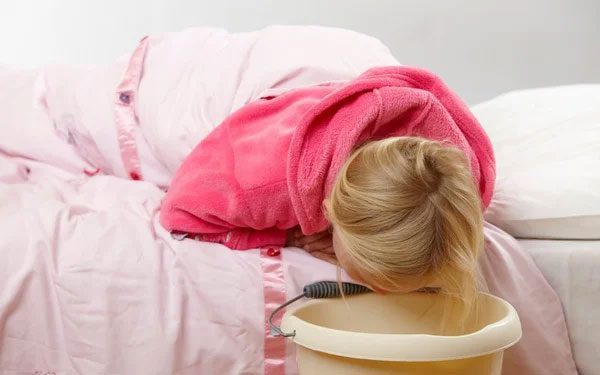As Covid-19 cases decrease, many mothers are on edge as their children continuously vomit and experience stomach pain without a clear cause.
When bringing her child to the Pediatrics Department at Bach Mai Hospital, Ms. Le Hang from Hoang Mai, Hanoi, reported that her 4-year-old daughter had been vomiting since the day before. Initially, the vomiting was mild. Ms. Hang thought it was due to food or that her daughter had choked on candy while playing. However, by noon, the vomiting persisted, prompting the preschool teacher to call Ms. Hang to pick up her daughter.
At home, the vomiting worsened. After each episode, the child requested water but would vomit again along with stomach pain. Ms. Hang gave her daughter anti-nausea medication prescribed by a doctor when she had Covid-19 over two months ago. However, the next day, her daughter was extremely fatigued and lost her appetite, leading Ms. Hang to take her for a check-up. The doctor noted that the child was vomiting excessively and had an electrolyte imbalance, advising Ms. Hang to admit her daughter for intravenous fluids. In the hospital room, many children similar to her daughter were also experiencing green and yellow bile vomiting.
Dr. Nguyen Manh Cuong, a pediatric specialist at Military Hospital 103, stated that recently, the department has been receiving many children admitted for vomiting, with some even showing signs of severe dehydration and lethargy. Some children were vomiting accompanied by diarrhea.

Recently, many children have been hospitalized due to vomiting, causing great concern among parents.
Dr. Cuong advised parents to recognize signs of vomiting accompanied by acute diarrhea, such as having loose stools or watery stools with blood more than twice within 24 hours.
Digestive symptoms include: Excessive vomiting, inability to drink water, poor appetite, and multiple loose or watery stools.
Should children who vomit take anti-nausea medication?
Signs of dehydration include: the child is very thirsty, eagerly drinking (grabbing the cup or eagerly listening for the sound of pouring water), or more severely, unable to drink, having sunken eyes, and potentially crying without tears. In cases of severe dehydration, the child may initially be agitated and then lethargic. Infants may show a sunken fontanelle.
When a child is vomiting, parents should monitor them and follow appropriate home treatment, such as supplementing with low-osmolarity oral rehydration salts (similar to standard oral rehydration salts but with lower concentrations): A study conducted in five developed countries involving children aged 1 month to 2 years with diarrhea and dehydration showed that using oral rehydration salts with low sodium and glucose concentrations reduced the need for intravenous fluids by 33%. The “improved” oral rehydration salts are as safe and effective as standard oral rehydration salts in preventing and treating dehydration from all types of diarrhea, while also reducing stool volume (by 20%) and providing other significant clinical benefits. The vomiting rate also decreased by 30%.
Parents should supplement zinc for their children: This helps in the quick recovery of intestinal mucosal cells. For children under 6 months: supplement with 10 mg of elemental zinc/day for 10-14 days. For older children, 20 mg/day for 10-14 days.
Use of anti-nausea medication or antibiotics should be prescribed by a doctor.
Probiotics: These help boost the immune system and protect the intestinal mucosa; if there is no effect after 3 days, discontinue use.
Racecadotril: This product helps reduce stool water content and should be used in the first 3 days, especially for significant secretory diarrhea, at a dose of 1.5 mg/kg every 8 hours. Breastfeeding children should continue to breastfeed and may need to increase their intake.
Recommended dosage for oral rehydration salts: For children under 24 months, drink 50-100 ml of oral rehydration salts after each episode of diarrhea, with a maximum of 500 ml. For children aged 2-10 years: drink 100-200 ml after each episode, with a maximum of 1000 ml. For children over 10 years, drink according to need, but not exceeding 2000 ml.
Symptoms that require immediate hospital admission include:
- If the child vomits more than 4 times in 1 hour or 6 times in 4 hours.
- If the child cannot drink or vomits after drinking.
- If the child has multiple uncontrolled bowel movements, or if the stools contain mucus or blood and have a foul smell.
- If an infant has a sunken fontanelle and cannot feed.
- If the child cries without tears, has sunken eyes, shows delayed skin turgor, cannot drink, and does not respond when called.
According to Dr. Cuong, common mistakes to avoid include:
- Taking antibiotics without knowing the cause, which reduces the elimination of pathogens and toxins, and using medications to suppress vomiting.
- Restricting the child’s diet: This can lead to malnutrition; giving sweet drinks can worsen diarrhea and accelerate dehydration as it draws water into the intestines.
Effective prevention methods, as advised by Dr. Cuong, include frequent hand washing, avoiding unfamiliar foods, not sharing utensils, limiting mouthing of toys, eating cooked foods, and drinking boiled water.



















































